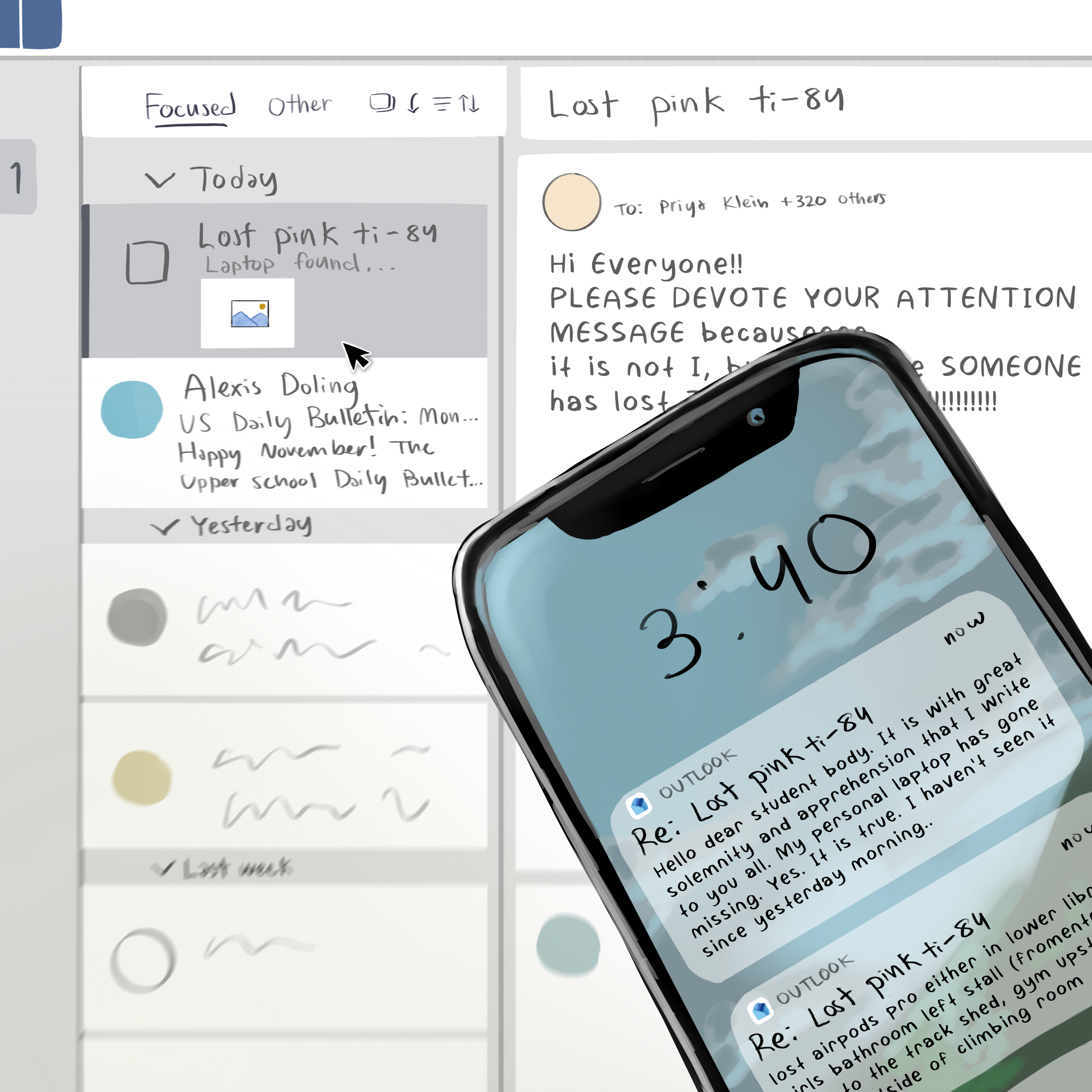The trials and tribulations of the lost and found email chains
By Priya Klein ‘26
Courtesy of Ila Reynolds-Kienbaum ‘27.
On Nov. 8, 2023, Violet Bouwes-van Nood ‘23 sent what she thought would be a one-time plea to the students of the Upper School via email: help her find her missing AirPods. She playfully reassured her classmates that she believed in their honesty and collaboration efforts, offering amnesty to any would-be thief, and urging everyone to keep the email between students. An hour later, she triumphantly announced that the AirPods had been recovered—and invited her peers to “use this chain for all school emails without teachers.”
Over the following school year, the same email thread became a sprawling, student-run lost-and-found system with requests for missing water bottles, calculators, and clothing. More than 20 individual students added to the chain by October 2024.
Bouwes-van Nood remembers writing that initial email at Moberi with her friends, mostly as a joke. “I did not expect the chain to be even used after I sent that out,” she said.
Beyond simply being a place to post lost items, the email chain became a hub of community activity. Many students embellished their all-class emails with jokes and appreciations. Other students used the thread’s accessibility to seek out other help from the student community, like for collecting artwork for their portfolio.
What made this email chain so precarious was its ambiguity under Catlin’s all-school email policy. Given that the chain was not explicitly allowed under this policy, it was crucial that no teachers or administrators be included on the address list and that students and new classes be manually added, as opposed to added through ‘!ClassOf’ commands which included Derek and John.
While there isn’t a formally published all-school email policy, Head of Upper School Derek Kanarek clarified in an interview that students are generally advised not to spam and to contact teachers before using mass mailing lists for academic or community-wide messages. When a student misuses them, administrators typically “just reach out to request that they stop”—a response he says usually does the trick.
That balance between freedom and restraint came to a head during the 2025 CGSA elections. Candidate Winston Wray ‘28 used the thread to promise that, if elected secretary, he would migrate lost-and-found alerts into the Daily Bulletin. “As your secretary, I would make sure that this is the last ever [email] sent on this chain,” he wrote.
For Theo Fisher ‘27, this was a step too far. “I viewed Winston’s email as trying to politicize a thing that every student had access to, and I thought that was a dumb thing,” he said. He promptly replied-all to Winton’s email, defending the chain and asking for help locating his own missing carabiner.
The tension quickly escalated beyond student politics when Kanarek—who had been accidentally added to the chain in the chaos of including the new class of freshmen–replied to Fisher’s email. Kanarek reminded students that mass emails must refrain from “spam or self-amusement,” and instead remain “essential.” His message made it clear that this grassroots communication channel was on thin ice.
Following Kanarek’s warning, a student restored the chain to include only student emails. They manually added the entire ninth-grade class, a task that would prove to be tedious but necessary for the vitality of the thread.
In a survey of students who have contributed to these email chains, 82% of lost items emailed about were found. Some students surveyed viewed the chain as useful for finding items, while others felt it was annoying and crossed into junk mail. “It feels like it used to be useful, but now it feels more spammy,” one anonymous student wrote.
Months after Kanarek’s warning, at the beginning of the 2025-2026 school year, Layla Hewitt ‘27 created an entirely new email chain that included the new class of freshmen—though this time, it had a different intention. “This year I wanted to be the first person to start it so that I could let everyone know what the unspoken and respectful expectations and boundaries come with this email chain,” said Hewitt. In multiple replies to the original email, Hewitt clarified the guidelines for the new chain: to be respectful and use the thread sparingly.
Hewitt warned that if the email chain is overused, emails could get lost, and fewer people would find their items. Beyond effectiveness, Hewitt worried about students spamming the email chain: “Many students are very busy during the day, and a spam email chain can be distracting and can turn into a larger issue if abused,” Hewitt said.
Bouwes-van Nood once feared the email chain would haunt her inbox forever. Now, having graduated—and having long since broken those AirPods in the washing machine—she views it fondly from afar. “The fact that this is my legacy at Catlin is hilarious,” she said.
Two years after the original inquiry about AirPods, the chain persists. Its continued success depends entirely on students who choose a responsible community over chaos. As long as no one spams, snitches, or campaigns too aggressively, the lost & found chain lives on.

